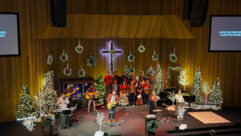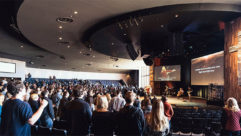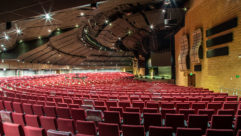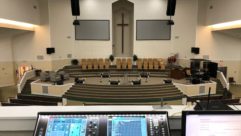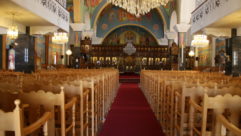
Sound Advice: Sound in the Worship Space
Jan 1, 2008 12:00 PM,
By Dan Daley
Understanding the HOW in acoustics.

For a recent remodel at the Southwest Church of Christ in Jonesboro, Ark., Audio Design Specialists of Madison, Wis., designed the acoustics, including a ceiling cloud package to provide a visual upgrade and supply a rich source of early reflections of the congregation’s singing.
I had a literature professor in college who demanded that everyone in his class always have a Bible and a thesaurus with them. The thesaurus we could all figure out, but the Bible perplexed and — this being heathen-friendly New York — annoyed some in the class. Until, that is, the professor began to connect the dots between the names and stories in the Bible and those in Western literary canons. Basically, he was saying, you can’t completely understand literature without being able to relate its themes and characterizations to other cultural touchstones, including and especially the Bible.
Now, if we could just figure out what they’re saying in the sanctuary over the music.
As the religious music genre has grown into a $500-million-plus category, it has also become as diversified as, if not more than, its secular counterpart. Christian music alone reaches into rock, pop, rap, R&B, metal, and gospel. What’s not comparable to the secular universe, though, is finding many of these variants on the same stage. The diversity of religious music, coupled with the fact that houses of worship are increasingly being used as multipurpose spaces — housing theatrical and other presentations, as well as music and religious services — has created a kind of intelligibility crisis. Or, more to the point, how do you establish systems and sonics that let you have it all and still get the message across intelligibly?
As some churches are learning, if you can’t be all venues to all people, then how do technology and acoustics limit you or define you?
Bill Thrasher, senior president and principal consultant of the Thrasher Design Group in Kennesaw, Ga., has outfitted plenty of houses of worship in his time. He says even the terminology of religious music has become obfuscatory, creating a kind of techno-cultural Babel that can impact the way the space and its sound system go together.
“Some rooms are simply not suitable for certain types of music,” Thrasher says. “A highly reverberant space is great for classical liturgical music, but it’s absolutely horrible for any music that’s fast and complicated — after the first few notes, all you’ve got is train wreck. But in talking to music pastors about what kind of music they foresee a church being used for, you’d be surprised at how many simply call it all ‘contemporary.’ That’s the problem: How can you hope to communicate with your community if you can’t accurately communicate with your audio integrator?”
You’re doing yourself and your potential HOW client a favor if you get an acoustically astute professional involved in systems design early in the process. I use the term “acoustically astute professional” purposefully. Acousticians are, of course, the field’s specialists, but there are other, often more affordable alternatives you can call on in, say, a bid stage. Acoustics can be a subjective science, with any data open to interpretation and often influenced by personal philosophies, as many acousticians will concede after the third or fourth beer.
Gary Zandstra, sales and marketing manager at Parkway Electric in Holland, Mich., suggests the conflict between liturgical and theatrical applications in a space mirror the issues between sound systems and acoustics.
“I continually see the struggle between creating a hybrid of what I call the theater experience and the congregational experience,” Zandstra says. “On one hand, the modern church wants a rock-and-roll performance space where the band sounds spectacular. On the other hand, there is a burning desire to have the space feel like you are part of a community of believers.
“I am reminded of a story one of the industry’s top consultants told me many years ago. He was recalling one of his early speaker-system designs for a performance hall. He was slated to mix opening night on the newly installed speaker system. Because of scheduling and travel issues, he did not arrive until just minutes before the final rehearsal. He walked in and looked up at the speaker cluster that looked like it was reasonably installed, went to the mix position, and was pleasantly surprised at how good it sounded. Later, as he reflected on why it sounded good right out of the gate, he came to the conclusion that the contractor could have probably pointed the speakers at the ceiling and it would have sounded good, because the acoustics in the room were so good. I wish it were a trend that every space would get as much acoustical attention as architectural and aesthetic attention.”
Don’t hold your breath. However, the science of modeling a space and predicting and tuning it virtually has advanced significantly. In fact, a key paper prepared in 2003 at the Technical University of Denmark (and Danes know sound) called “Room Acoustic Simulation and Auralization” relied heavily on the acoustic properties of Byzantine churches and mosques in Istanbul. Auralization is the process of rendering audible, via physical or mathematical modeling, the sound field of a source in a space in a way that simulates the listening experience at any given position in the modeled space.
It’s heady stuff, but necessary if you’re going to address a multipurpose space. Fortunately, there are more and more software applications on the market that help make sense of the math of auralization. These include CATT-Acoustic — room modeling, data simulation, auralization, and room- and electroacoustics (www.catt.se); CARA — room modeling, low-frequency analysis, and loudspeaker positioning (www.cara.de); RPG Diffusor Systems room sizer/optimizer — rectangular rooms, ratios, and loudspeaker and listener positions (www.rpginc.com); and Morset Sound Development WinFlag — absorber design and sound-transmission calculations (www.winflag.com).
The outcomes are worth the effort. John Storyk, principal/designer for Walters-Storyk Design Group in Highland, N.Y., recalls predicting and then correcting the acoustics of the 1,500-seat Vassar University church in 2006 using a combination of acoustical treatments and DSP-controlled loudspeaker systems.
But installers have become more adept at giving a worship space as much latitude as can be wrung out for it. John Westra, president of Audio Design Specialists of Madison, Wis., says the first step in accomplishing this goal is to have a source that is as phase-coherent as possible.
“We typically employ Tannoy dual-concentric drivers to satisfy this requirement,” Westra says. “The second step is knowing, in multiple source arrays, the appropriate magnitude of separation between elements. The third step is suppression of reflections within a critical time window, which may be by absorptive treatment, diffusive treatment, or both. A potential fourth step is minimization of the separation between the source and the listener. Where appropriate, multiple longitudinally spaced sources can be used with time delays, but these delayed sources should be displaced in the direction of the platform and over-delayed by about 7 milliseconds, so that their presence is not detectable. Done properly, the results can be dramatic. We had one large liturgical church with a 5-second reverberation time for organ. The intelligibility was sufficiently high that elderly members quit using the hearing-assistance subsystem.
“Contrary to popular belief, you do not need short reverberation times for high intelligibility, and you do not need to rely upon high-Q transducers, which commonly have reduced sound quality as a byproduct of their increased directivity. The reverberation time, therefore, can be optimized for the music program — relatively short for a contemporary format or relatively long for a traditional format — without [impinging upon] the intelligibility of speech.”
Houses of worship have the biggest challenge of all when it comes to audio — to be a place where the message can be gotten across in a plethora of media and art forms, some of which are inherently going to be pretty loud. Acoustics is the place to start to look for the answers.
Audio ColumnistDan Daleywas a partner and CFO at Pyramid Recording Studios in New York, where he also engineered records and audio for television, including MTV’s The Big Show.


